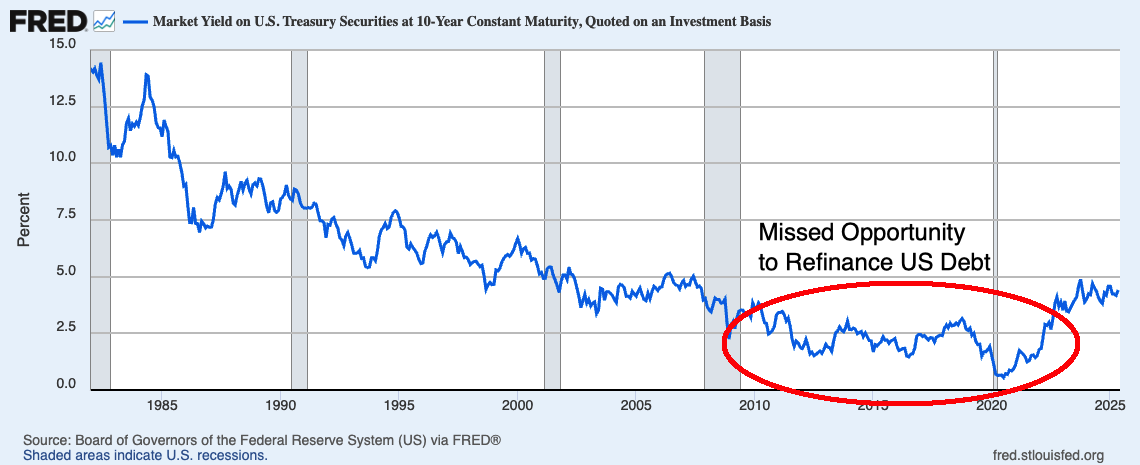

I’m heading to my new office in Chicago and meeting clients in San Francisco. However, after hearing misinformation on television from regular suspects, I felt compelled to remember people some important facts about US debt and deficits.
The US enjoyed incredibly low interest rates over the 20 years that began after the attack on September 11th, accelerated after the GFC and ran to a rate hike in 2022.
All reasonable parties have refinanced their liabilities, whether it is short-term, medium-term, or long-term. This includes homeowners. Many still enjoy the lowest average mortgage rate on record, locking up to a sub-5%, or even a 4% or 3% rate. It also includes Corporate America, which refinances its long-term debt at a low cost.
Certainly, it involves all Americans saving one entity: America itself.
With 10-year Treasury bonds being nearly 4.5% (and nearly 7% mortgages), dollars being avoided by global trading partners, and US bonds sending sinister warnings, you might wonder why America didn’t do what American households and businesses did in the 2010s. Refinance all of your outstanding debts cheaply.
Some of you will soon cry.”Hindsight bias. “To you, I share the following column written in the mid-2010s:
2013:
The Federal Reserve’s zero interest rates and quantitative easing policy make borrowing costs low generations. The cost of funding repairs and renovations of America’s collapsed infrastructure is as cheap as it has been since World War II.
But the era of cheap credit may be coming to an end. And thanks to the dysfunctional Washington, DC, we are saving you from missing out on a once-in-a-lifetime opportunity.
2014:
Despite the enormous US fundraising needs, interest rates have been lowered. Today we appear to face a long bond shortage as our hunger for the Treasury remains unconfirmed.
The simple equation is: Treasury Demand + Ultra-low Fees + Large and sustainable US funding needs = Long bonds.
If we are smart, and all signs as a nation, We are not particularly prominent in financial decisions – Introduce 50 years of financial obligations. Other countries have done so, and more recently Canada.
2015:
There are ways to solve many problems that are often overlooked.
All of them have a single solution: issue longer bonds, preferably 30 or 50 years of securities.
Much of what the US can fix by refinancing debts at today’s low rates and issuing new bonds to fund repairs to collapse infrastructure.
2016:
Regardless of the country in question, a good approach to fund this debt suggests long-term bonds, whether matured for 30 or 50 years.
Which countries does the above explain? It could be one of the following:
Canada
Spain
France
Switzerland
UK
Italy
Ireland
Belgium
MexicoThey are all currently funding some of their debts on 50-year bonds. Ireland and Belgium, like Mexico, offer 100-year bonds. And since the 1990s, 100-year mortgages have been in Japan. More and more companies are issuing 100-year bonds.
All this was obvious to those paying attention. There should have been a bipartisan perception of this obvious fundraising opportunity, but alas, as Twain very appropriately stated, “I assume you’re an idiot, and I assume you were a member of Congress.
The once-in-a-lifetime opportunity to put America on the healthiest financial foothold possible has been missed. Whether it’s ideology, economic myriad, or simply stupidity, it doesn’t matter. What’s important is the cost that Congress in the 2010s lasts for generations, if not more…
Previously:
Fix your infrastructure to something cheap while you can still
Washington Post, July 12, 2013
Mirror of the big picture
Do you need 50 years of bonds?
The US must take advantage of low interest rates to issue long-term bonds. Bloomberg, May 5, 2014
Mirror of the big picture
Bonds that can cure diseases in America
Much of what the US can fix by refinancing debts at today’s low rates and issuing new bonds to fund repairs to collapse infrastructure.
Bloomberg, March 19, 2015.
Mirror of the big picture
50-year US bonds make more sense than ever
It issues debts that capitalize on near-recorded fees while funding the country’s long-term obligations.
Bloomberg, May 19, 2016
Mirror of the big picture
Please refer:
We are witnessing the power of the bond market to intimidate
By Jeff Somer
NYT Strategy, May 30, 2025
The stock market remains undefeated (May 19, 2025)
Mib Gary Cohn, Director of National Economic Council and President of Goldman Sachs (September 29, 2023)
The biggest missed opportunity of our life (October 23, 2023)








